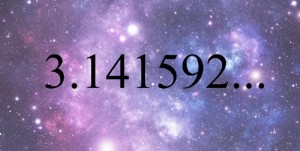God has built many surprises into the universe for us to discover and enjoy. One of them is the number pi which begins with 3.141592… and continues on for at least 13 trillion digits, perhaps forever.
What is so special about this number? Simply this: it shows up throughout nature in the most surprising places, even though it is based on the measurement of circles and spheres.
You probably know that when we take the distance around a circle (its circumference) and divide it by the distance across it (its diameter), the answer is always pi or 3.141529….
Thus, in a sense, pi describes or even defines the very nature of circles and spheres.
But it keeps on popping up in other descriptions of the world, too. A scientist or mathematician can be working away on some or other problem and, unexpectedly, pi shows up again! Whenever there is wave motion, or periodically repeated motion, or a curve, we now expect pi to appear, but there are still surprises, such as Boll’s 1991 discovery of pi in fractals. Throughout the ages pi has been found in:
- Geometry and trigonometry
- Pendulums and other objects that repeat their motion periodically
- The uncertainty principle of quantum mechanics
- General relativity
- Electromagnetism
- Statistics
- Fractals
- And many other topics in mathematics
Why should this be so? Only God knows. The number pi, as well as other intriguing numbers and the correspondences between mathematics and the physical world, astound and mystify many scholars. As atheist Eugene Wigner, Nobel Prize winner in physics, wrote in The Unreasonable Effectiveness of Mathematics in the Natural Sciences,
“It is difficult to avoid the impression that a miracle confronts us here, quite comparable in its striking nature to the miracle that the human mind can string a thousand arguments together without getting itself into contradictions, or to the two miracles of the existence of laws of nature and of the human mind’s capacity to divine them…. The miracle of the appropriateness of the language of mathematics for the formulation of the laws of physics is a wonderful gift which we neither understand nor deserve.”
Yes, Wigner is right. This is a miracle, and many of us do not realize it.
In fact, although the number pi was probably not widely used at the time of Job (~1500 BC) and its power is still being discovered in our time, it, like the mysteries of Orion and the dawn and the enormous leviathan, is an example of the Creator’s overpowering greatness (Job 38-41). For those who learn about pi, its mysteries can join these other answers to Job’s anguished pleas.
For those of us who believe in a God who designed and created both the world and us, nature overflows with clear signs of his might. We see, in an amazing variety of ways–including pi–God’s eternal power and divine nature (Rom 1:20).
So Pi Day is an opportunity for us to celebrate the majesty of the Creator who has given us both the world and the ability to begin to unravel its mysteries. It is also a reminder to accept, like Job did at the end, the incomprehensible questions of life, relying on the fact that the One in charge obviously does know what he is doing.
How will our family celebrate The Pi Day of the Century this Saturday, 3-14-15? I’m sure Miss 17 will wear her pi shirt. We might make and eat pies. But most importantly, we will thank God for all the wonder and order and mystery and meaning he has built into this beautiful world of ours, and for the opportunity to discover it.
May God bless you this Pi Day as you focus on this fascinating aspect of his creation.
An aside: Years ago, during our mealtime Bible reading, I realized with great excitement that in the descriptions of Solomon’s temple, pi was not used. Both the circumference and the diameter of the bronze pool (the sea) were listed (1 Kings 7:23), although if pi were used only one of these would need to be given. Now, this may be because one of the numbers measured the inside of the rim and the other the outside, but it may also just be because pi was not in common use, although by this time (~1000 BC) it had been known for at least 800 years.
—
For more about homeschooling, see Finishing Strong, and Trivium Tuesdays. For other encouragement, visit Raising Homemakers, Titus 2 Tuesday, Works for Me Wednesday, Mom to Mom Monday, Monday’s Musings, Missional Weekend, R&R Wednesdays, From House to Home, Homemaking Mondays, Good Morning Mondays, Make Your Home Sing Mondays, Faith Filled Fridays.


I love posts like this! It makes me think and glorify our Creator, too!! Awesome God! I’ll share my recent post (although I didn’t write it and am just sharing it) with you on much the same vein: http://www.deeprootsathome.com/the-biggest-case-for-god-science-itself/
Hug to you, Annie Kate!
Thank you so much for that link, Jacqueline. It really points to the evidence for a designer, doesn’t it? God’s Undertaker and The Soul of Science are two books on the same topic.
And thank you for your encouragement!
That is sure fascinating! I love your perspective on how we should respond when we think about pi =)